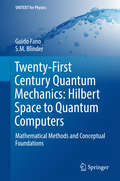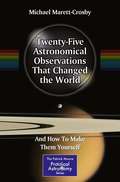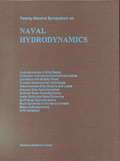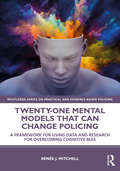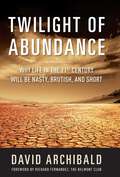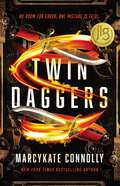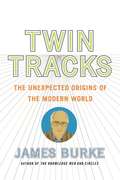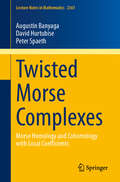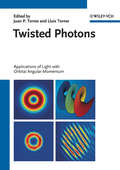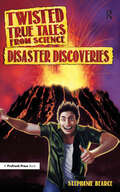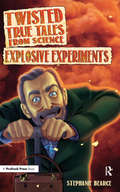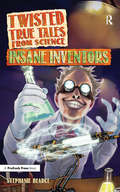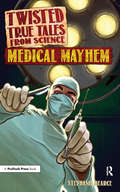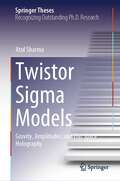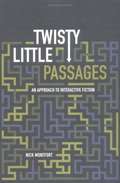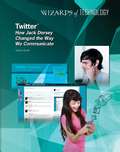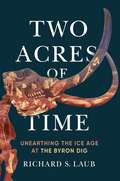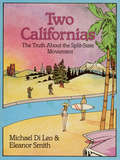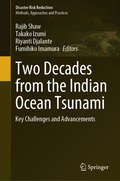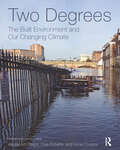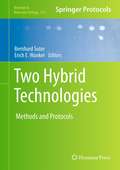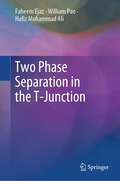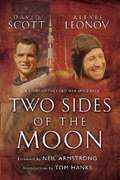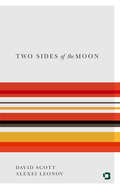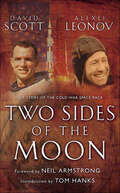- Table View
- List View
Twenty-First Century Quantum Mechanics: Hilbert Space to Quantum Computers
by Guido Fano S M BlinderThis book is designed to make accessible to nonspecialists the still evolving concepts of quantum mechanics and the terminology in which these are expressed. The opening chapters summarize elementary concepts of twentieth century quantum mechanics and describe the mathematical methods employed in the field, with clear explanation of, for example, Hilbert space, complex variables, complex vector spaces and Dirac notation, and the Heisenberg uncertainty principle. After detailed discussion of the Schr#65533;dinger equation, subsequent chapters focus on isotropic vectors, used to construct spinors, and on conceptual problems associated with measurement, superposition, and decoherence in quantum systems. Here, due attention is paid to Bell's inequality and the possible existence of hidden variables. Finally, progression toward quantum computation is examined in detail: if quantum computers can be made practicable, enormous enhancements in computing power, artificial intelligence, and secure communication will result. This book will be of interest to a wide readership seeking to understand modern quantum mechanics and its potential applications.
Twenty-Five Astronomical Observations That Changed the World: And How To Make Them Yourself
by Michael Marett-Crosby"Twenty-Five Astronomical Observations That Changed the World" takes twenty-five journeys through space, back in time and into human history. We begin with the simplest sight of the Tycho Crater on the Moon, through a repeat of Galileo's observations of Jupiter's moons, and then move out towards the nebulae, stars, and galaxies. The astronomical observations repeat the original groundbreaking discoveries that have changed our understanding of science and ourselves. This title contains graded observing challenges from the straightforward to the more difficult (in chapter order). It offers clear observing tips and lots of practical help, presuming no prior in-depth knowledge of equipment. Binoculars and/or a small astronomical telescope are all that is required for most of the observations. Secondly, it explores for each observation the science of what is seen, adding to the knowledge and enjoyment of amateur astronomers and offering lots of reading for the cloudy nights when there is not a star in view. Thirdly, the book puts the amateur astronomers' observations into a wider perspective. "Twenty-Five Astronomical Observations That Changed the World" makes the observer part of that great story of discovery. Each chapter, each observing challenge, shows how to observe and then how to look with understanding. The projects begin with practicalities: where the object is, how best is it observed and with what appropriate equipment (usually a small-to-medium aperture amateur telescope, binoculars, even the naked eye). "Twenty-Five Astronomical Observations that Changed the World" guides even the inexperienced amateur astronomer - beginners can use the book - around a variety of night-sky objects, and reminds the more experienced how they can best be seen. These practical observations put us in contact with all the history and culture surrounding them: through scientific speculation and literature to those first fuzzy images made in 1959 by the Russian space probe Luna 3.
Twenty-Second Symposium on Naval Hydrodynamics
by National Research CouncilConference held August 9-14, 1998 in Washington, D.C. Organized jointly by the Office of Naval Research, The NRC and the Naval Surface Warfare Center, Carderock Division. Promotes the technical exchange of naval research developments of common interest to all the countries of the world.
Twenty-one Mental Models That Can Change Policing: A Framework for Using Data and Research for Overcoming Cognitive Bias (Routledge Series on Practical and Evidence-Based Policing)
by Renée J. MitchellThis book goes beyond other police leadership books to teach practitioners how to think about policing in a structured way that synthesizes criminological theory, statistics, research design, applied research, and what works and what doesn’t in policing into Mental Models. A Mental Model is a representation of how something works. Using a Mental Model framework to simplify complex concepts, readers will take away an in-depth understanding of how cognitive biases affect our ability to understand and interpret data, what empirical research says about effective police interventions, how statistical data should be structured for management meetings, and how to evaluate interventions for efficiency and effectiveness. While evidence-based practice is critical to advancing the police profession, it is limited in scope, and is only part of what is necessary to support sustainable change in policing. Policing requires a scientifically based framework to understand and interpret data in a way that minimizes cognitive bias to allow for better responses to complex problems. Data and research have advanced so rapidly in the last several decades that it is difficult for even the most ambitious of police leaders to keep pace. The Twenty-one Mental Models were synthesized to create a framework for any police, public, or community leader to better understand how cognitive bias contributes to misunderstanding data and gives the reader the tools to overcome those biases to better serve their communities. The book is intended for a wide range of audiences, including law enforcement and community leaders; scholars and policy experts who specialize in policing; students of criminal justice, organizations, and management; reporters and journalists; individuals who aspire to police careers; and citizen consumers of information about policing. Anyone who is going to make decisions about their communities based on data has a responsibility to be numerate and this book Twenty-one Mental Models That Can Change Policing: A Framework For Using Data and Research For Overcoming Cognitive Bias, will help you become just that.
Twilight of Abundance: Why Life in the 21st Century Will Be Nasty, Brutish, and Short
by David ArchibaldBaby boomers enjoyed the most benign period in human history: fifty years of relative peace, cheap energy, plentiful grain supply, and a warming climate due to the highest solar activity for 8,000 years. The party is over-prepare for the twilight of abundance.David Archibald reveals the grim future the world faces on its current trajectory: massive fuel shortages, the bloodiest warfare in human history, a global starvation crisis, and a rapidly cooling planet. Archibald combines pioneering science with keen economic knowledge to predict the global disasters that could destroy civilization as we know it-disasters that are waiting just around the corner.But there's good news, too: We can have a good future if we prepare for it. Advanced, civilized countries can have a permanently high standard of living if they choose to invest in the technologies that will get them there. Archibald, a climate scientist as well as an inventor and a financial specialist, explains which scientific breakthroughs can save civilization in the coming crisis-if we can cut through the special interest opposition to these innovations and allow free markets to flourish.
Twin Daggers
by MarcyKate ConnollyAissa&’s life is a web of carefully constructed lies. She and her twin sister, Zandria, are Magi spies, a magical people most believe to be extinct. And they&’re on a mission for revenge. This action and adventure spy thriller—a fantasy spin on &“Romeo and Juliet&” from New York Times bestselling author MarcyKate Connolly—is perfect for fans of Marissa Meyer and Elly Blake and is about to become your new obsession!By day, Aissa and Zandra play the role of normal young Technocrats eager to fulfill the duties of their new apprenticeships. By night, they plot their revenge to retake their city from the Technocrats. But then Aissa is given a new mission: find and kidnap the heir to the Technocrat throne, who is rumored to be one of the Heartless—a person born without a working heart who survives via a mechanical replacement—and has been hidden since birth.Aissa is more likely to be caught than to be successful, but she's never been one to turn down an assignment, even if the hunt is complicated by a kind Technocrat researcher who is determined to find a cure for the Heartless. But when Zandria is captured by the Technocrats, Aissa will do anything to get her sister back. Even if it means abandoning all other loyalties and missions … and risking everything by trusting her sworn enemies.
Twin Tracks: The Unexpected Origins of the Modern World
by James BurkeTwin Tracks is a landmark book of real-world stories that investigates the nature of change and divines as never before the unlikely origins of many aspects of contemporary life. In each of the work's twenty-five narratives, we discover how the different outcomes of an important historical event in the past often come together again in the future.<P><P> Each chapter starts with an event -- such as the U.S. attack on Tripoli in 1804 -- that generates two divergent series of consequences. After tracking each pathway as it ranges far and wide through time and space, Burke shows how the paths finally and unexpectedly converge in the modern world.<P> Twin Tracks pinpoints the myriad ways the future is shaped, whether by love, war, accident, genius, or discovery. For instance, in "The Marriage of Figaro to Stealth Fighter," Burke's twin tracks start with the composer of the opera and the French spy from whose play he stole the plot. The tracks then encompass, among other things, freemasonry, the War of Independence, Captain Cook, jellyfish, Jane Austen, and audio tape. Ultimately, the convergence of the two Figaro tracks sets the stage for the development of Gulf War Stealth aircraft.<P> Wonderfully accessible and lucidly written, Twin Tracks offers an amusing and instructive new view of the past and the future.
Twisted Morse Complexes: Morse Homology and Cohomology with Local Coefficients (Lecture Notes in Mathematics #2361)
by Augustin Banyaga David Hurtubise Peter SpaethThis book gives a detailed presentation of twisted Morse homology and cohomology on closed finite-dimensional smooth manifolds. It contains a complete proof of the Twisted Morse Homology Theorem, which says that on a closed finite-dimensional smooth manifold the homology of the Morse–Smale–Witten chain complex with coefficients in a bundle of abelian groups G is isomorphic to the singular homology of the manifold with coefficients in G. It also includes proofs of twisted Morse-theoretic versions of well-known theorems such as Eilenberg's Theorem, the Poincaré Lemma, and the de Rham Theorem. The effectiveness of twisted Morse complexes is demonstrated by computing the Lichnerowicz cohomology of surfaces, giving obstructions to spaces being associative H-spaces, and computing Novikov numbers. Suitable for a graduate level course, the book may also be used as a reference for graduate students and working mathematicians or physicists.
Twisted Photons: Applications of Light with Orbital Angular Momentum
by Juan P. Torres Lluis TornerThis book deals with applications in several areas of science and technology that make use of light which carries orbital angular momentum. In most practical scenarios, the angular momentum can be decomposed into two independent contributions: the spin angular momentum and the orbital angular momentum. The orbital contribution affords a fundamentally new degree of freedom, with fascinating and wide-spread applications. Unlike spin angular momentum, which is associated with the polarization of light, the orbital angular momentum arises as a consequence of the spatial distribution of the intensity and phase of an optical field, even down to the single photon limit. Researchers have begun to appreciate its implications for our understanding of the ways in which light and matter can interact, and its practical potential in different areas of science and technology.
Twisted True Tales From Science: Disaster Discoveries
by Stephanie BearceLondon was once covered in a fog so polluted that it killed 12,000 people. The Aleppo earthquake killed 230,000 people, and a wall of water mysteriously wiped out the whole town of Burnham-on-Sea. All of these were catastrophic disasters, but they led to important discoveries in science. Learn about how the earth turned to liquid in New Zealand and what happens when a tsunami meets a nuclear reactor. These stories may sound twisted and strange, but they are all true tales from science!Ages 9-12
Twisted True Tales From Science: Explosive Experiments
by Stephanie BearceTwo thousand years ago, Chinese scientists were looking for a medicine that would make them live forever. Instead, they blew up their lab and discovered gunpowder. Alfred Nobel blew up his laboratory twice before he discovered the formula for dynamite. Learn about the Apollo 13 and Challenger explosions and the strange space explosions caused by top secret Starfish Prime. These stories may sound twisted, but they're all true tales from science!Ages 9-12
Twisted True Tales From Science: Insane Inventors
by Stephanie BearceNikola Tesla was crazy smart. He invented the idea for cell phones in 1893, discovered alternating current, and invented a death ray gun. Of course, he also talked to pigeons, ate only boiled food, and was scared of women who wore jewelry. He was an insane inventor. So was Henry Cavendish, who discovered hydrogen, calculated the density of the Earth, and was so scared of people that he had to write notes to communicate. Sir Isaac Newton discovered the laws of gravity, believed in magic, and thought he could make a potion to create gold. These stories may sound twisted, but they're all true tales from science!Ages 9-12
Twisted True Tales From Science: Medical Mayhem
by Stephanie BearceGround-up mummy bones, leeches sucking human blood, and a breakfast of dried mouse paste. It sounds like a horror movie, but those were actual medicines prescribed by early doctors. Medical students studied anatomy on bodies stolen from graves and had to operate on people while they were awake. Learn about the medicines that came from poison and doctors who experimented on themselves and their families. It's a twisted tale of medical mayhem, but it's all true!Ages 9-12
Twistor Sigma Models: Gravity, Amplitudes, and Flat Space Holography (Springer Theses)
by Atul SharmaIn recent decades, twistor theory has grown into an irreplaceable tool for the study of scattering amplitudes in gauge theory and gravity. This book introduces the reader to cutting-edge advances in twistor theory and its applications to general relativity. The problem of graviton scattering in four dimensions is shown to be dual to dramatically simpler computations in a two-dimensional CFT known as a twistor sigma model. Twistor sigma models are the first step toward a holographic description of gravity in asymptotically flat space-times. They underpin the infinitely many asymptotic symmetries of flat space physics discovered in celestial holography, and extend them to exciting new arenas like curved space-times. They also yield intrinsically mathematical results in the field of hyperkähler manifolds. This volume will be of broad interest to students and researchers looking for an accessible entry point into twistor geometry, scattering amplitudes, and celestial holography. It will also provide an invaluable reference for specialists by bringing together results from a host of different disciplines.
Twisty Little Passages: An Approach to Interactive Fiction
by Nick MontfortFrom the Book Jacket: Interactive fiction-the best-known form of which is the text game or text adventure-has not received as much critical attention as have such other forms of electronic literature as hypertext fiction and the conversational programs known as chatterbots. Twisty Little Passages (the title refers to a maze in Adventure, the first interactive fiction) is the first book-length consideration of this form, examining it from gaming and literary perspectives. Nick Montfort, an interactive fiction author himself, offers both aficionados and first-time users a way to approach interactive fiction that will lead to a more pleasurable and meaningful experience of it. Twisty Little Passages looks at interactive fiction beginning with its most important literary ancestor, the riddle. Montfort then discusses Adventure and its precursors (including the I Ching and Dungeons and Dragons), and follows this with an examination of mainframe text games developed in response, focusing on the most influential work of that era, Zork. He then considers the introduction of commercial interactive fiction for home computers, particularly that produced by Infocom. Commercial works inspired an.independent reaction, and Montfort describes the emergence of independent creators and the development of an online interactive fiction community in the 1990s. Finally, he considers the influence of interactive fiction on other literary and gaming forms. With Twisty Little Passages. Nick Montfort places interactive fiction in its computational and literary contexts, opening up-this-still-developing form to new consideration.
Twitter®: How Jack Dorsey Changed the Way We Communicate
by Celicia ScottIn the modern world, Twitter has changed the way we talk to each other, the way we share important news, and the way we learn about the world. You've probably heard of movie celebrities, politicians, and sports stars using Twitter to communicate with fans, but the social networking site has also done a lot to change the way ordinary people use the Internet. It's even changed the way we speak! Discover the story of Jack Dorsey, Twitter's co-founder, and how he helped to create one of the Internet's biggest successes. Learn how Jack and his friends came up with the ideas for the business that would change their lives--and the lives of so many Internet users--forever.
Two Acres of Time: Unearthing the Ice Age at the Byron Dig
by Richard S. LaubIn 1959, what appeared to be the bones of a mastodon were found in a western New York pasture. When researchers began to investigate further in the early 1980s, the site proved to hold far more. Known as the Hiscock Site, it contained an astonishingly rich trove of fossils and artifacts dating from the late Ice Age through the onset of European settlement. For nearly three decades, work at the site—the “Byron Dig”—unearthed new evidence of changing fauna, flora, cultures, and environments over the past 13,000 years.In Two Acres of Time, Richard S. Laub—the principal investigator of the project—tells the story of the Byron Dig. Recounting twenty-nine years of intensive excavation involving more than a thousand participants, he provides a comprehensive account of a working paleontological and archaeological field project and its contributions to our knowledge of the past. Laub explores how understanding of the site evolved through the years, the surprises that came to light along the way, and how contributions from numerous researchers helped achieve a fuller picture of the significance of the findings. The book also shows how people from all walks of life—not only scientists but also volunteers and local small-town residents—worked together to unearth and interpret the site’s contents and to preserve them for future generations. This extensively illustrated book connects life at a scientific excavation project to the grand sweep of long-ago epochs, and is a compelling read and resource for researchers and general readers alike.
Two Californias: The Myths And Realities Of A State Divided Against Itself
by Eleanor Smith Michael Di LeoTwo Californias explores for the first time the pervasive folk myth that Northern and Southern California should really be separate states. You hear it all the time in the media and on the street - but is it true? Michael DiLeo and Eleanor Smith look closely and discover that there are profound truths embedded in the folk tradition. And equally profound misconceptions. Probing the surprising and little-known history of the split-state movement, the authors find that its underlying sentiments have been part of California politics and culture since territorial days. What the issues are today, what their implications are for our lives in the 1980s, and what we can do about them are the focus of this fascinating book. The current water controversy, perhaps the most crucial in the state's history, cannot be resolved until the two Californias make peace with each other. No other book confronts the environmental and philosophical problems that plague California and have nationwide echoes as thoroughly and as intelligently as Two Californias does. Two Californias is entertaining - and it also thought-provoking. It is very likely to change the ways we think about living together and sharing resources in the 1980s.
Two Decades from the Indian Ocean Tsunami: Key Challenges and Advancements (Disaster Risk Reduction)
by Rajib Shaw Takako Izumi Riyanti Djalante Fumihiko ImamuraThis book presents the advancements in the disaster risk reduction and resilience building in the countries affected by the Indian Ocean Tsunami countries. The book includes a few cross-cutting issues related to governance, technology, and communities, with two major parts: (1) cross-cutting issues and (2) regional and country level experiences. At the threshold of twenty years from Indian Ocean Tsunami, the concept of disaster risk reduction field has evolved significantly in the affected countries as well as around the world. Globally, several mega disasters happened in the last 20 years, and risk landscape has become more complex. In addition, technology, governance, and people’s resilience have gained positive momentum. We had two world conferences on disaster risk reduction, resulting in two global disaster risk reduction frameworks, which aligned with development frameworks as well as climate change agreements. COVID-19 and post COVID risk landscape has brought the new dimension of compound and complex disasters and need for all hazards’ approach.
Two Degrees: The Built Environment And Our Changing Climate
by Alisdair McGregor Cole Roberts Fiona CousinsThe Earth’s temperature has been rising. To limit catastrophic outcomes, the international scientific community has set a challenging goal of no more than two degrees Celsius (3.6 degrees Fahrenheit) average temperature rise. Economists agree we will save trillions of dollars by acting early. But how do we act successfully? And what’s the backup plan if we fall short? Setting politics aside, Two Degrees reviews the current science and explains how we can set practical steps to reduce the extent of warming and to adapt to the inevitable changes, all while improving the bottom line, beautifying our communities, and increasing human health. The book is a practical guide intended for a broad audience of those who occupy and shape our built environment. The authors provide a clear framework for communities, policy makers, planners, designers, developers, builders, and operators to help manage the impacts and capture the opportunities of our changing climate. Two Degrees is divided into three sections—Fundamentals, Mitigation, and Adaptation—covering a diverse array of topics ranging from climate-positive communities and low-carbon buildings to the psychology of choice and the cost of a low-carbon economy. After a foreword by Amory Lovins, more than 10 contributing authors share knowledge based on direct experience in all aspects of built environment practice. This book clarifies the misconceptions, provides new and unique insights, and shows how a better approach to the built environment can increase resilience and positively shape our future.
Two Hybrid Technologies
by Bernhard Suter Erich E. WankerProtein-protein interactions (PPIs) are strongly predictive of functional relationships among proteins in virtually all processes that take place in the living cell. Therefore, the comprehensive exploration of interactome networks is one of the major goals in systems biology. The aim of Two Hybrid Technologies: Methods and Protocols is to provide a compendium of state-of-the art protocols for the investigation of binary PPIs with the classical yeast two-hybrid (Y2H) approach, Y2H variants and other in vivo methods for PPI mapping. Divided into two convenient sections, the first gives a survey of protocols that are currently employed for Y2H high-throughput screens by different expert labs in the field. Rather than detailing the principles of screening, which have been described previously, the focus is on different implementations of Y2H interactome mapping. The second section of the book considers innovative PPI detection methods that have the potential to emerge as alternative high-throughput methodologies. Written in the highly successful Methods in Molecular BiologyTM series format, chapters contain introductions to their respective topics, lists of the necessary materials and reagents, step-by-step, readily reproducible laboratory protocols, and notes on troubleshooting and avoiding known pitfalls. Authoritative and accessible, Two Hybrid Technologies: Methods and Protocols supplies researchers with a comprehensive toolbox for the identification of biologically relevant protein interactions.
Two Phase Separation in the T-Junction
by Hafiz Muhammad Ali Faheem Ejaz William PaoThis book provides a comprehensive yet concise knowledge and understanding in the field of Two-phase separation in the T-Junction. and this book can not only contribute to the academics, but it can also provide valuable insight for the industrial use of the T-junction.This book discusses in detail, the effect of different parameters on phase separation. These independent variables include diameter ratio, velocity ratio, individual phase velocities, side arm inclination, main arm inclination, mass split ratio, density of the working fluid, types of T-junctions used and modification in the T-Junction. The objectives and goals of this books are concerned with the research involved with the heat transfer applications, fluid mechanics and flow transmission in the petroleum field. Currently the data from the literature indicates that there is no specific source of consistent conclusion about the multiphase phenomenon. This book can provide a database of knowledge keeping in view of all the previous studies of the recent decades.So, engineers performing their duties in their respective sector, graduate and Ph.D students in the field of engineering can get valuable information about Two Phase Separation in the T-Junction.
Two Sides of the Moon: Our Story of the Cold War Space Race
by David Scott Neil Armstrong Christine Toomey Tom Hanks Alexei LeonovSpace was one of the most fiercely fought battlegrounds of the Cold War, the Moon its ultimate beachhead. In this dual autobiography,Apollo 15 commander David Scott and cosmonaut Alexei Leonov, the first man to ever walk in space, recount their exceptional lives and careers spent on the cutting edge of science and space exploration—and their participation in the greatest technological race ever—to land a man on the Moon. With each mission fraught with perilous tasks, and each space program touched by tragedy, these parallel tales of adventure and heroism read like a modern-day thriller. Cutting fast between their differing recollections, this book reveals, in a very personal way, the drama of one of the most ambitious contests ever embarked on by man, set against the conflict that once held the world in suspense: the clash between Communism and Western democracy. Through the men's memoirs, their courage, passion for exploration, and determination to push themselves to the limit, emerge not only through their triumphs but also through their perseverance in times of extraordinary difficulty and danger. "Two Sides of the Moon is unique among space histories. If you are looking for a balanced, interesting, and personal account of the American and Soviet space programs during the 1960s and 1970s this is it. " ---Astronomy Magazine
Two Sides of the Moon: Our Story of the Cold War Space Race
by David Scott Alexei LeonovWith a foreword by Neil Armstrong and an introduction by Tom HanksIn this unique dual autobiography, astronaut David Scott and cosmonaut Alexei Leonov recount their exceptional lives and careers spent on the cutting edge of science and space exploration. This book reveals, in a very personal way, the drama of one of the most ambitious contests ever embarked on by man, set against the conflict that once held the world in suspense: the clash between communism and Western democracy. Through the men’s memoirs, their courage emerges from their perseverance in times of extraordinary difficulty and danger.
Two Sides of the Moon: Our Story of the Cold War Space Race
by David Scott Alexei LeonovGrowing up on either side of the Iron Curtain, David Scott and Alexei Leonov experienced very different childhoods but shared the same dream to fly. Excelling in every area of mental and physical agility, Scott and Leonov became elite fighter pilots and were chosen by their countries' burgeoning space programs to take part in the greatest technological race ever-to land a man on the moon. In this unique dual autobiography, astronaut Scott and cosmonaut Leonov recount their exceptional lives and careers spent on the cutting edge of science and space exploration. With each mission fraught with perilous risks, and each space program touched by tragedy, these parallel tales of adventure and heroism read like a modern-day thriller. Cutting fast between their differing recollections, this book reveals, in a very personal way, the drama of one of the most ambitious contests ever embarked on by man, set against the conflict that once held the world in suspense: the clash between Russian communism and Western democracy.Before training to be the USSR's first man on the moon, Leonov became the first man to walk in space. It was a feat that won him a place in history but almost cost him his life. A year later, in 1966, Gemini 8, with David Scott and Neil Armstrong aboard, tumbled out of control across space. Surviving against dramatic odds-a split-second decision by pilot Armstrong saved their lives-they both went on to fly their own lunar missions: Armstrong to command Apollo 11 and become the first man to walk on the moon, and Scott to perform an EVA during the Apollo 9 mission and command the most complex expedition in the history of exploration, Apollo 15. Spending three days on the moon, Scott became the seventh man to walk on its breathtaking surface. Marking a new age of USA/USSR cooperation, the Apollo-Soyuz Test Project brought Scott and Leonov together, finally ending the Cold War silence and building a friendship that would last for decades. Their courage, passion for exploration, and determination to push themselves to the limit emerge in these memoirs not only through their triumphs but also through their perseverance in times of extraordinary difficulty and danger.
